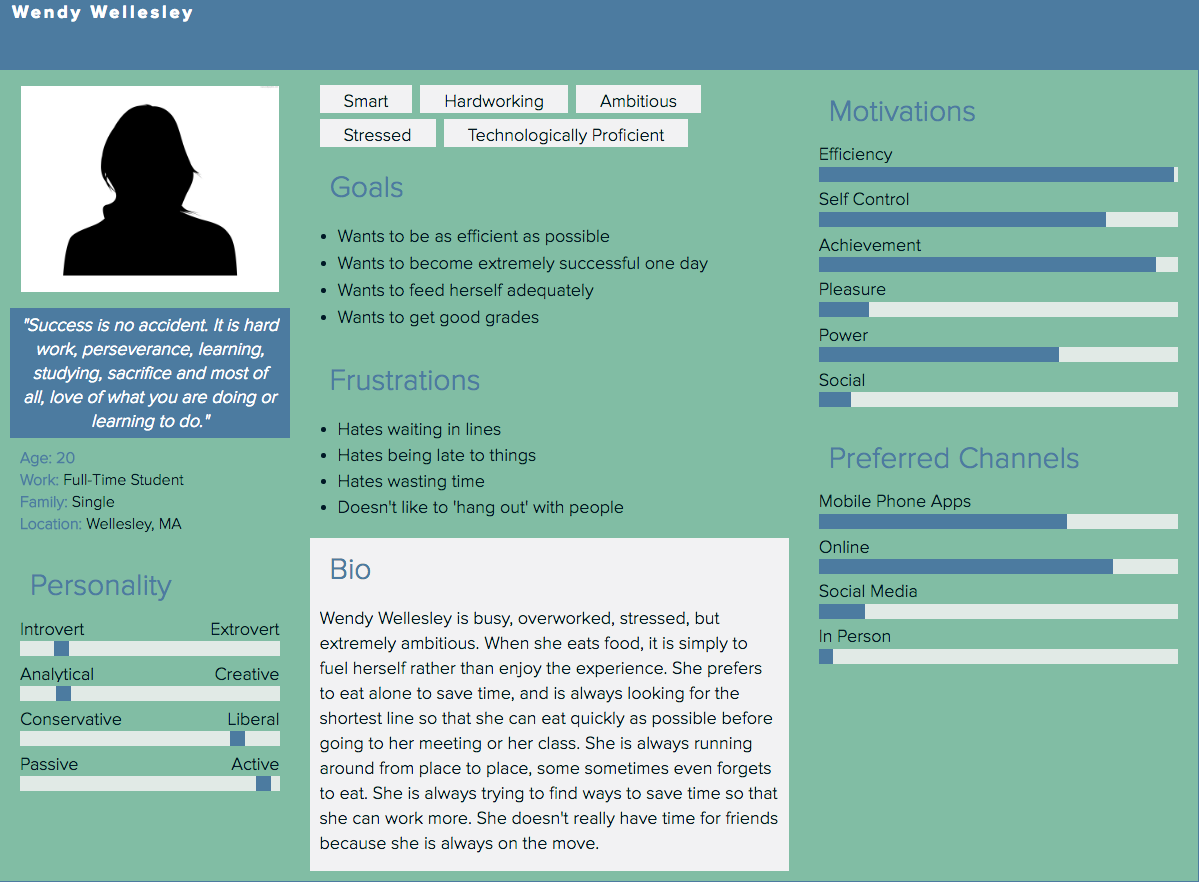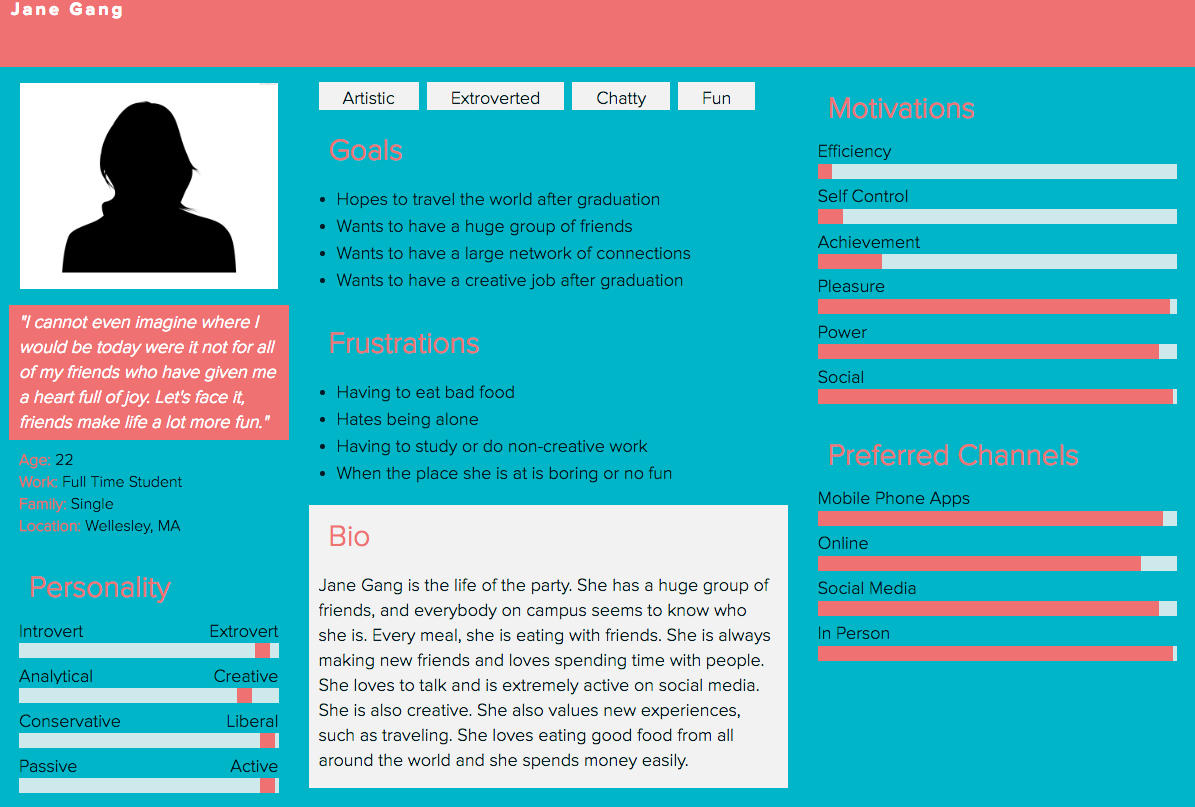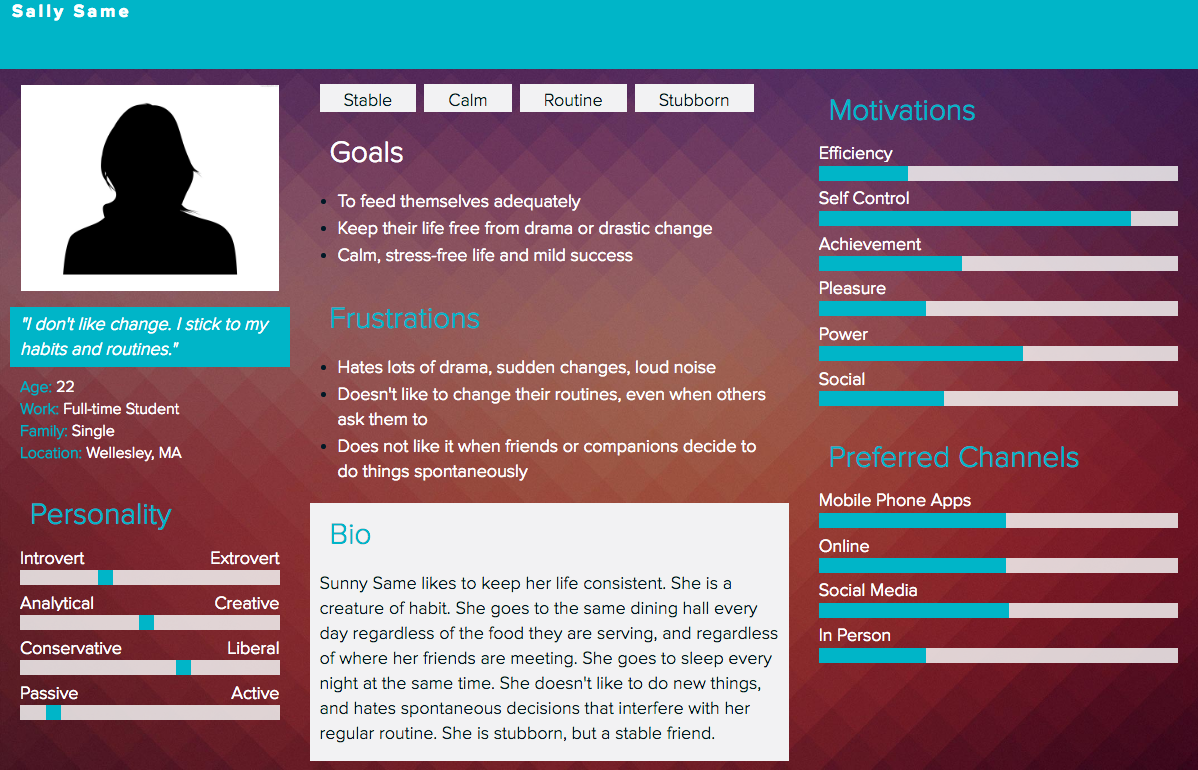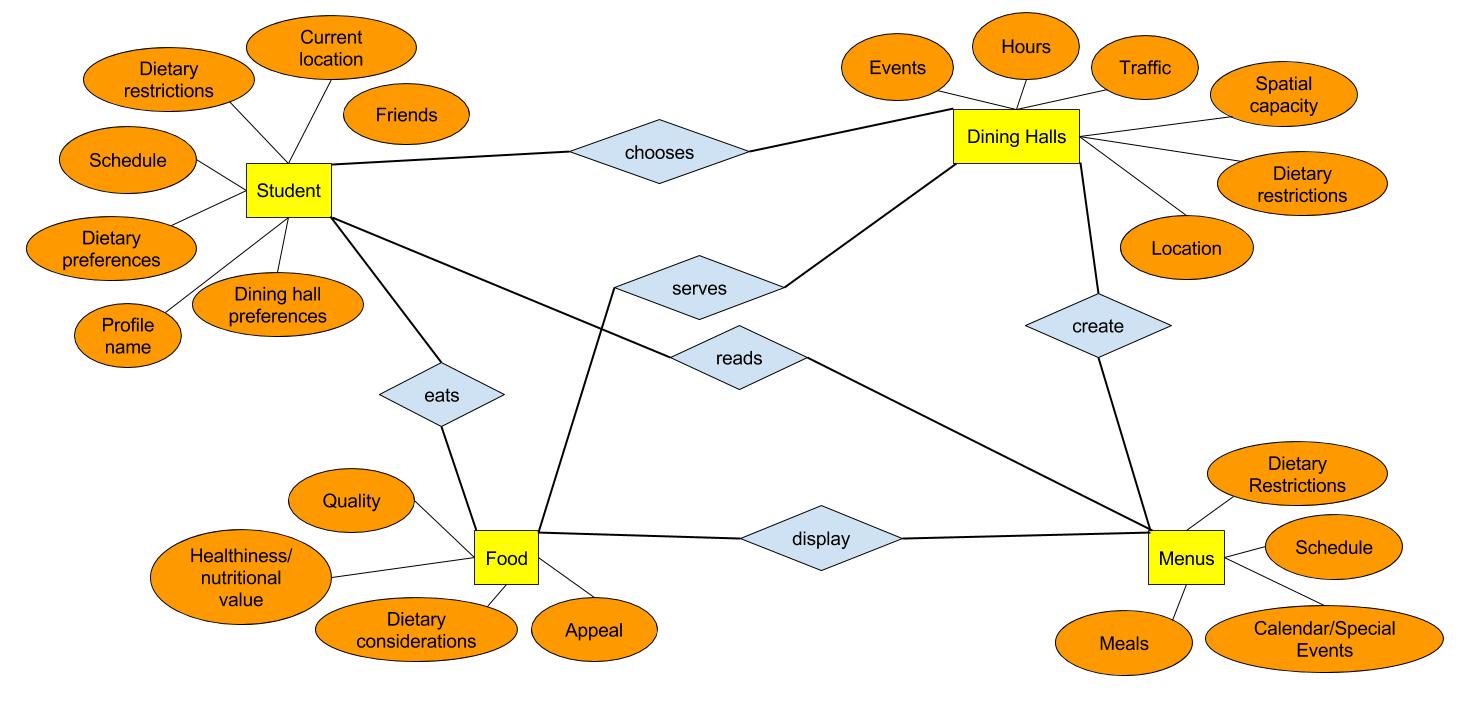Requirement Analysis and Preliminary Design
User Analysis
This mobile web application is targeted specifically toward users who are students of Wellesley College. This user group is predominantly female, between the ages of 18 and 22, have at least a high school education, and English-speaking. They are proficient with technology and experienced with mobile technology, as most of them have easy access to mobile devices and technology. They also are likely to frequently use mobile technology in their daily lives for communication, social media, and other purposes. Most have social groups contained within Wellesley College. They are mobile and can move between buildings and dining halls, and their common motivation for going to a dining hall is to eat food.
Interview Summaries
Student One: For Student One, location and convenience matters more than what food the dining hall is serving. When entering the dining hall, the student immediately assesses the traffic of the dining hall - if it is extremely busy, she looks for an open spot or table immediately before even entering the dining hall so that she can 'save' herself and her friend(s) a spot. She is aware of when the traffic in dining halls tends to be higher (12:30 at lunch time). Student One tries to choose times to eat in which the traffic tends to be lower (before 12:30 or after 1pm), or go to dining halls that tend to be less popular or have more space, because she doesn't like waiting in line and she likes sitting at her own table with her friends. Therefore, it seems like Student One's first priority is to avoid high traffic. She is willing to go to different dining halls or change her eating times in order to avoid high traffic and to have the most convenience. When she is actually getting food in the dining hall, she walks by each station in the dining hall and observes each option before deciding what to eat. Then she will come around a second time to each station with a plate, and add the food to her plate. Clearly, traffic and location are the most important things she thinks about before deciding where to eat.
Student Two: For Student Two, both convenience and the food offered is most important to her when deciding where to eat. To choose where to eat, she will most likely pick the two dining halls nearest to her and check Wellesley Fresh to see which one has the best vegan options, since she is vegan. She will pick which dining hall to go to based on which one has more, or better sounding vegan dishes on the menu. She isn't as concerned with the traffic - she goes whenever she is hungry and does not change her eating schedule around traffic. Usually, she will eat during peak times. However, it is a plus if the dining hall happens to be empty or does not have long lines. When she walks into the dining hall, she walks to each station, and reads the label, and if the food is vegan and she finds it appetizing, she will add it to her plate before moving on to the next station. She complains about the lack of vegan options on campus and in different dining halls, how Wellesley Fresh sometimes does not label their food at all, and talks about how sometimes vegan food can be mislabeled (once a flank steak was labeled vegan). She hates walking into a dining hall and seeing zero vegan options for her other than the salad bar. Clearly, the menu and location are the most important things she thinks about before deciding where to eat.
Student Three: For Student Three, eating the best food, or her favorite comfort foods, is the most important to her. If a dining hall is serving her favorite dish, or her favorite type of food (ie. Mexican), then she will travel there, no matter how far away, how inconvenient, and how high the traffic. She will cross campus just to have her favorite food. If a dining hall is having a special event (ie cheese), she will put on it on her calendar and make sure not to miss it. She sometimes finds the dining hall lacking in good food, but if there is good food to be had, she will be there. When she goes to the dining hall to get food, she will beeline to the station with the food that she wants, ignore the other stations, and just eat that one dish. Clearly, the menu is the most important thing she consults before deciding where to eat.
Student Four: For Student four, she has developed a certain loyalty to a specific dining hall, near her dorm room. She is a creature of habit, and usually just eats at the same dining hall every single day, for every meal, without giving any thought to the menu, which dining hall might be closer to her current location. Even if the dining hall has high traffic, bad food, or limited options for her, she continues to eat there every day, and doesn't bother even visiting other dining halls. If meeting up with her friends, she will most likely insist that everybody meet at her favorite dining hall, because she does not feel any desire to go to any other place to eat. When she goes into the dining hall to get food, she just goes to every single dish and gets a little bit of every dish. She claims that her dining hall has the best food, and there is no reason for her to ever leave.
Student Five: For Student Five, the most important thing to her is that she never eats alone. She always wants to meet and eat with friends. Therefore, she always chats and texts her friends to see when and where they are eating lunch or dinner for the day, and she will go wherever they happen to be. She loves it when she happens to see a friend in the dining hall. She talks about how sometimes it is difficult to find out where and when all of her friends are, and what their plans are. She also states that what the dining hall is serving and the location of the dining hall isn't as important to her. When she makes plans with friends, they decide on the dining hall to go to based on how near it is to everybody's location. Clearly, student five's friends' locations are the most important thing that she consults before deciding where to eat.
User Personas




Task Analysis
High Level Tasks
- Check each dining hall
- Check menu
- Check hours
- Check dietary restrictions
- Check traffic
- Check satisfaction
- Choose a dining hall
- Go to a dining hall
- Rate Traffic
- Submit allergens
- Submit dietary restrictions
- Rate satisfaction
- Check in
- Check status of friends
- View profile of individual friend
- View friend’s location
- View badges of friend
- Check profile
- View own badges
- View notifications
- Disable notifications
Questions to Ask about Task
- Where are the tasks performed?
- On the way to or from class
- During class downtime
- In a dorm room
- In the dining hall
- Study spots on campus (Pendleton Atrium, Clapp Library)
- On the way back to campus for a meal
- What is the environment like?
- Quiet
- Dorm room
- Study spots
- Bus
- Loud
- Walking between classes
- Classrooms
- Dining Halls
- How often is the task performed?
- As often as the user eats on campus (can be multiple times in a day)
- How is the task learned?
- Self-taught
- Being taught by another user
- What can go wrong?
- Dining hall information is not updated for a day (i.e. menus or hours)
- Food information is not updated for a meal (i.e. new dietary information)
- Indicators fail to reset (i.e. traffic and satisfaction)
- Who else is involved in the task?
- User
- User's friends, if they are sharing a status
- User’s friends, if they are using the app together
Hierarchal Task Diagram

Domain Analysis
